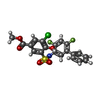+Search query
-Structure paper
| Title | An allosteric mechanism for potent inhibition of human ATP-citrate lyase. |
|---|---|
| Journal, issue, pages | Nature, Vol. 568, Issue 7753, Page 566-570, Year 2019 |
| Publish date | Apr 3, 2019 |
 Authors Authors | Jia Wei / Silvana Leit / Jun Kuai / Eric Therrien / Salma Rafi / H James Harwood / Byron DeLaBarre / Liang Tong /  |
| PubMed Abstract | ATP-citrate lyase (ACLY) is a central metabolic enzyme and catalyses the ATP-dependent conversion of citrate and coenzyme A (CoA) to oxaloacetate and acetyl-CoA. The acetyl-CoA product is crucial for ...ATP-citrate lyase (ACLY) is a central metabolic enzyme and catalyses the ATP-dependent conversion of citrate and coenzyme A (CoA) to oxaloacetate and acetyl-CoA. The acetyl-CoA product is crucial for the metabolism of fatty acids, the biosynthesis of cholesterol, and the acetylation and prenylation of proteins. There has been considerable interest in ACLY as a target for anti-cancer drugs, because many cancer cells depend on its activity for proliferation. ACLY is also a target against dyslipidaemia and hepatic steatosis, with a compound currently in phase 3 clinical trials. Many inhibitors of ACLY have been reported, but most of them have weak activity. Here we report the development of a series of low nanomolar, small-molecule inhibitors of human ACLY. We have also determined the structure of the full-length human ACLY homo-tetramer in complex with one of these inhibitors (NDI-091143) by cryo-electron microscopy, which reveals an unexpected mechanism of inhibition. The compound is located in an allosteric, mostly hydrophobic cavity next to the citrate-binding site, and requires extensive conformational changes in the enzyme that indirectly disrupt citrate binding. The observed binding mode is supported by and explains the structure-activity relationships of these compounds. This allosteric site greatly enhances the 'druggability' of ACLY and represents an attractive target for the development of new ACLY inhibitors. |
 External links External links |  Nature / Nature /  PubMed:30944472 PubMed:30944472 |
| Methods | EM (single particle) |
| Resolution | 3.67 - 4.11 Å |
| Structure data | EMDB-0567, PDB-6o0h:  EMDB-0568: |
| Chemicals |  ChemComp-LBG:  ChemComp-ADP: |
| Source |
|
 Keywords Keywords | ligase/ligase inhibitor / ATP-citrate lyase / LIGASE / ligase-ligase inhibitor complex |
 Movie
Movie Controller
Controller Structure viewers
Structure viewers About Yorodumi Papers
About Yorodumi Papers





 homo sapiens (human)
homo sapiens (human)